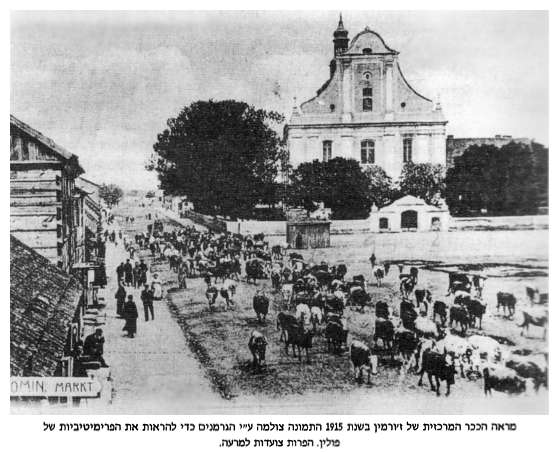 |
in order to show the primitiveness of Poland. The cows are marching to pasture.
|
[Inside front cover]
Our families are extremely thankful for the opportunity to republish this Memorial Book dedicated to the memory of the Jewish people of Zuromin who were victims of the Shoah. The history of our family in Poland…their childhood, their culture and their subsequent anguish brought on by World War II can be found in the pages of this book, written by the Zuromin survivors of the Holocaust. These chapters give a history of their personal struggle for survival and perseverance against fascism. It is a story that has imbued us to continue to strive for a world where bigotry, racism and anti-Semitism will be thrust onto the ashes of history.
In Remembrance:
The Rosenstein and Sklar Families
Teaneck, NJ 07666 January, 2002
[Page 1 - English] [Page 1 - Hebrew]
Elimelech Shklar
The remarkable history of Jewry in Poland existed for a millennium. The Jewish population consisted of three distinct communities. In the southern area, Galicia, previously under the rule of the Austrian emperor, Franz Jozef, Jews lived a democratic life, in relative wealth and with widespread public education. In the eastern area lived the Lithuanians, whose emphasis was Jewish culture, with the major cities – Vilna, also known as Yerushalayim DeLitta, and Bialystock, birthplace of the largest Jewish organizations: Zionism and the Bund. In different parts of Poland lived the third community, mainly merchants and craftsmen.
Warsaw the capital was the principal city, attracting Jewish intellectuals from all over Poland. About 100 kilometers northwest of Warsaw lived a small Jewish community in the God-forsaken town of Zuromin. Of a populace of about 6,000, 35% were Jews. This community earned its livelihood through commerce and crafts, knowing no crime, but rather the opposite. The town's poor were helped, travelers from faraway places were housed in a special apartment, reserved for hachnassat orchim (hospitality), and notes were given for Sabbath meals at Jewish homes. There were charitable organizations such as linat hazeddek, bikur cholim, including the lending of medical assistance, and hachnasat kala.
After Poland was declared independent in 1918, livelihoods were strained, causing many to emigrate in search of better luck. Preferred destinations were the United States, France, Mexico, Argentina and Uruguay. Indicative of the many difficulties that the youth had to face was the fact that no more than ten were able to attend high school in the big cities. The remaining Jews would continue struggling for a living until WWII.
Our hometown, Zuromin, was occasionally visited by traveling groups of gypsies, whose women were clairvoyant. I can clearly picture a gypsy lady, reading the palm of the head of our community, Mr. Mendelson, forseeing the tragedy which was yet to befall the town's Jewish residents. Such prophecy was never made, and had it been made, it would not have been believed. Even as winds of war were blowing from the west, communal life continued on its usual course.
On September 1st, 1939, six years of war began, and a horrible Shoah struck the Jewish people, our townspeople among them. Eventually, mere dozens survived the Holocaust, of whom most were saved in Russia, and a minority of concentration-camp survivors.
Assisted by Abraham and Shlomo Dragon, Mendel Braun and Solomon Plotka in the United States, and financed by many of Zuromin's community, I have erected a monument in memory of those who did not survive the Holocaust. The monument stands in Holon Cemetery and bears the names of all the households lost in the Holocaust. My hope is that our efforts to recover the original tombstones of the Jewish cemetery, which were used by the Nazis to pave the Ringewirtz family's yard, will be fruitful.
I thank all those who assisted in publishing this commemoration by sharing their experiences and donating their creations and family photographs, as I do my family, who assisted me in rewriting, editing and publishing.
|
|
| A view of the central square of Zuromin in 1915. The photo was taken by the Germans in order to show the primitiveness of Poland. The cows are marching to pasture. |
|
|
| A group of Bund members. Top row: Avraham Lichtman, Simcha and Peretz Gutenberg, Meilech Szklar, Rivka and Yaakov Szklar. Bottom row: Feiga Szklar, two emissaries of the organization, Henna Przecki. |
|
JewishGen, Inc. makes no representations regarding the accuracy of
the translation. The reader may wish to refer to the original material
for verification.
JewishGen is not responsible for inaccuracies or omissions in the original work and cannot rewrite or edit the text to correct inaccuracies and/or omissions.
Our mission is to produce a translation of the original work and we cannot verify the accuracy of statements or alter facts cited.
 Zuromin, Poland
Zuromin, Poland
 Yizkor Book Project
Yizkor Book Project
 JewishGen Home Page
JewishGen Home Page
Copyright © 1999-2025 by JewishGen, Inc.
Updated 29 Feb 2008 by LA